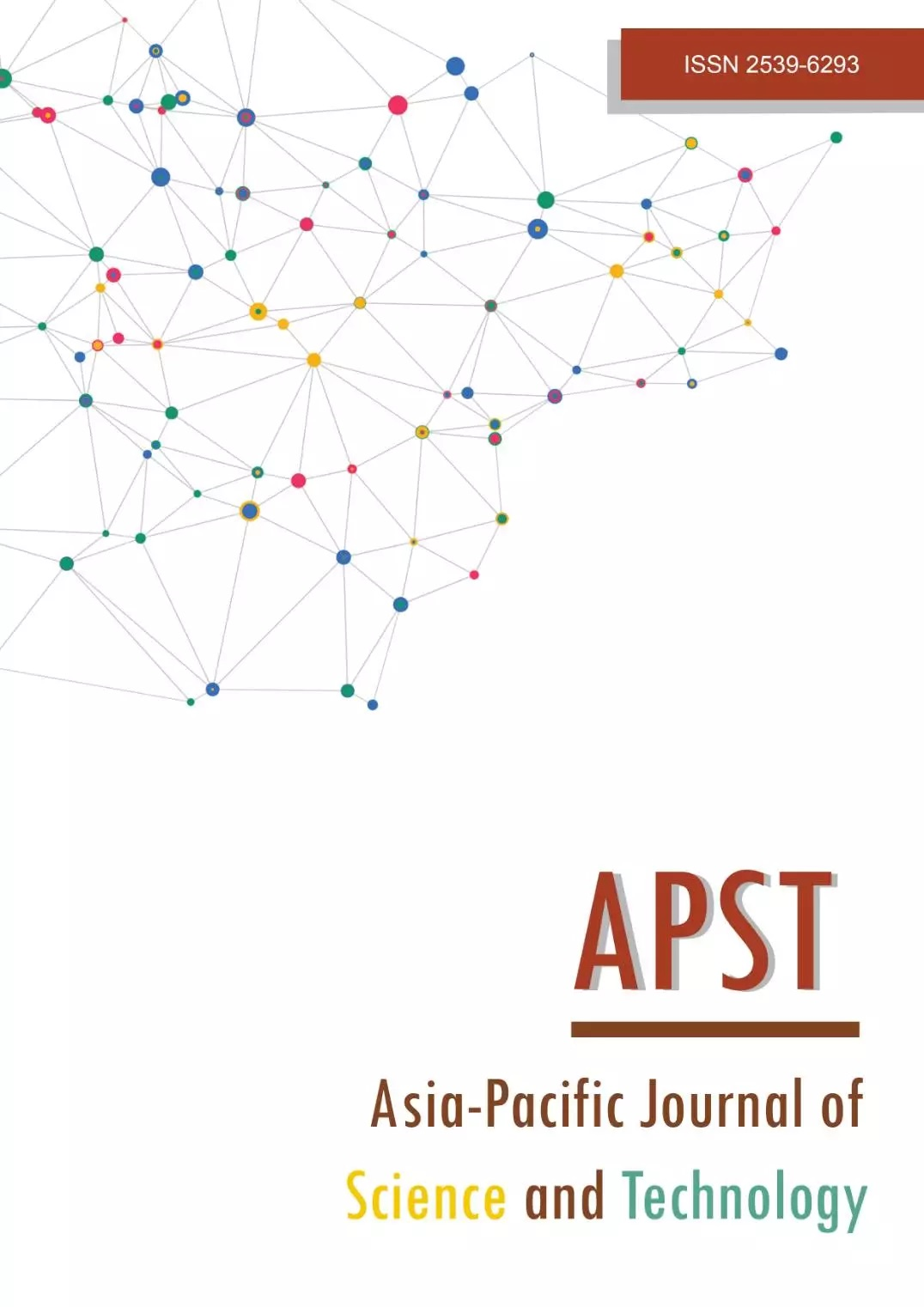Evaluation on the bean qualities of cocoa clones after propagated from somatic embryogenesis culture
Main Article Content
Abstract
A series of field experiments were conducted to assess the bean qualities of elite cocoa clones (KKM4, KKM22, MCBC1 and PBC230) after regenerated via somatic embryogenesis culture and grafting. The bean of all clones was morphologically and physically evaluated before quantified for the physiochemical changes after fermentation and drying processes. No abnormalities found in the morphological characteristics of beans for all treatments. However, KKM4 clone of immature zygotic embryo culture yielded distinctly difference lightest individual seed fresh weight (4.13 g), shortest seed length (21.2 mm) and seed width (11.5 mm) compared with those from the staminode culture and grafting. KKM4 clone of immature zygotic embryo culture also observed with the lowest moisture content (6.36%) and cut test score (674.4) of beans after fermentation and drying processes. From this study, some clone such as KKM4 exhibited variation after propagated from different type of explants during somatic embryogenesis culture. Nevertheless, the bean cut test score which fall within the standard range validated that the bean quality is not affected after the somatic embryogenesis culture process.
Article Details
References
Afoakwa EO, Kongor JE, Takrama JF, Badu AS. Changes in acidification, sugars and mineral composition of cocoa pulp during fermentation of pulp pre-conditioned cocoa (Theobroma cacao) beans. Int Food Res J. 2013;20:1215-1222.
Jayasekhar S, Ndungu I. Review of economic history of cocoa with special reference to India. J Plant Crops. 2018:46-51.
Kongor JE, Hinneha M, Walle DV, Afoakwa EO, Boeckk P, Dewettinck K. Factors influencing quality variation in cocoa (Theobroma cacao) bean flavour profile - A review. Food Res Int. 2016;82:44-52.
Schwan RF, Wheals AE. The microbiology of cocoa fermentation and its role in chocolate quality. Crit Rev In Food Sci Nutr. 2004;44:205-221.
Kyi TM, Daud WRW, Mohammad AB, Samsudin MW, Hassan KAA, Meor TMZ. The kinetics and polyphenol degradation during the drying of Malaysian cocoa beans. Int J Food Sci Technol. 2005;40:323-331.
Hii CL, Abdul RR, Jinp S, Jinp S, Che MYB. Quality of cocoa beans dried using a direct solar dryer at different loadings. J Sci Food Agric. 2006;86:1237-1243.
Efraim P, Pezoa GNH, Jardim DCP, Nishikawa A, Haddad R, Eberlin MN. Influence of cocoa beans fermentation and drying on the polyphenol content and sensory acceptance. Ciência e Natura. 2010;30:142-150.
Bairu MW, Aremu AO, Van Staden J. Somaclonal variation in plants: causes and detection methods. Plant Growth Regul. 2011;63:147-173.
Ajijah N, Randriani E, Rubiyo R, Sukma D, Sudarsono D. Keragaan tanaman kakao asal somatik embrio di lapangan. J Litri. 2015;21:57-68.
Goenaga R, Guiltinan M, Maximova S, Sequine E, Irizarry H. Yield performance and bean quality traits of cacao propagated by grafting and somatic embryo derived cutting. Hortic Sci. 2015;50:358-362.
Munsell AH. Munsell color charts for plant tissues. 2015 [cited 2020, July 30]; Available from: https://babel.hathitrust.org/cgi/pt?id=coo.31924050267594&view=1up&seq=37. 1952.
Khairul BS, Fazilah A, Tajul AY. Effect of cocoa pods storage on the temperature and physicochemical changes during shallow box fermentation. Int J Innov Sci Eng Technol. 2017;4:197-203.
Anon A. Malaysian cocoa monitor. Malaysian Cocoa J. 2002;1:1-30.
Khairul BS. Impact of fermentation duration on the quality of Malaysian cocoa beans using shallow box. Asia Pac J Sci Technol. 2014;19:74-80.
SIRIM’s medical device innovation centre (MDIC). Annex C cocoa bean specification for grading [Internet]. 2005 Department of Standards Malaysia [cited 2020, Jul 30]; Available from:https://www.google.com/search?q=Sirim+2005+cocoa+beans+malaysia&oq=Sirim+2005+cocoa+beans+malaysia&aqs=chrome..69i57.17123j0j4&sourceid=chrome&ie=UTF-8
Lowry L [Internet]. New York: VassarStats: Website for statistical computation [cited 2020, Jul 30].Available from: http://vassarstats.net/
Viet HLTV, Phung TH, Everaert H, Rottiers H, Lam PAT, Dung TN, et al. Characterization of leaf, flower, and pod morphology among Vietnamese cocoa varieties (Theobroma cacao L.). Pak J Bot. 2016;48:2375-2583.
Bidot MI, Valdés de la CM, Riera NM, Bertin P. Morphological characterization of traditional cacao (Theobroma cacao L.) plants in Cuba. Genet Resour Crop EV. 2017;64:73-99.
Martini MH, Lenci CG, Figuiera A, De queiroz TD. Localization of the cotyledon reserves of Theobroma grandiflorum (Willd. ex Spreng) K. Schum., T. subincanum Mart., T. bicolor Bonpl. and their analogies with T. cacao L. Rev Bras Frutic. 2008;31:147-154.
Cruz JFM, Leite PB, Soares SE, De silva EB. Assessment of the fermentative process from different cocoa cultivars produced in Southern Bahia, Brazil. Afr J Biotechnol. 2013;12:5218-5225.
Aryani LNPA, Yulianti NL, Arda G. Characteristics of cocoa beans on small capacity fermentation results based on different types of containers and different fermentation lengths. Journal Beta (Biosistem dan Teknik Pertanian). 2018;6:17-24.
Hernández HC, López APA, Ramírez GMA, Ramírez DG, Caballero JFP. Evaluation of different fermentation processes for use by small cocoa growers in Mexico. Food Sci Nutr. 2016;4:690-695.
Jinap S, Siti MH, Norsiati MG. Formation of methyl pyrazina during cocoa bean fermentation. Pertanika J Trop Agric Sci. 1994;17:27-32.
Guehi ST, Dabone S, Koffi LB, Kedjebo DK, Zahouli GIB. Effect of turning beans and fermentation method on the acidity and physical quality of raw cocoa beans. Adv J Food Sci Technol. 2010;2:163-171.
Pelaez PP, Bardon I, Camasca I. Methylxanthine and catechin content of fresh and fermented cocoa beans, dried cocoa beans and cocoa liquor. Sci Agropecu. 2016;7:355-365.
Hii HL, Law CL, Cloke M, Sharif S. Improving Malaysian cocoa quality through the use of dehumidified air under mild drying conditions. J Sci Food Agric. 2011;91:239-346.


